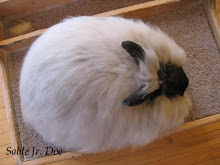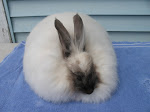More next time!

I have been doing alot of reading lately about various breeding systems, and not surprisingly there seems to be more than one idea on how to improve the quality of a rabbit line over time:).
Okay, LINEBREEDING is a system of breeding where rabbits are repeatedly bred back to other family members (uncle to niece, daughter to grandfather, granddaughter to grandfather, etc. etc. and so on down the line). The advantage to this type of breeding is that you are (assumably)concentrating superior genes and minimizing variation in a gene pool to make the breeding results more uniform and predictable. The disadvantage of this method is that when you practice it for a long period of time the overall vigor of your herd tends to decline as the animals become more homozygous, so that it becomes important to either: keep a very large herd in order to substantially widen your gene pool, or periodically introduce unrelated stock to invigorate and extend the life of your line. Linebreeding is critical to the success of any serious breeder, and the only real way to produce consistent, high-quality stock.
INBREEDING is the mating of brother to sister in order to force recessive genes to express themselves OR increase the homozygosity of a herd to the point where the GOOD qualities are so firmly set that there is an excellent chance that the traits will be passed down, even when the rabbit is bred to an inferior quality animal later and again to it's own offspring. Inbreeding is a tool to use when you have linebred for a long period of time and want to set your good traits as firmly as possible. It is also good to do when you have been diligently culling out recessives over time and want to see what remains to weed out. It's sort of the culmination of a good breeding program, in a way:).
Now, there also seem to be opposing theories as to how to go about improving the specific qualities of your line. Once school of thought says that you need to breed together animals who are virtual 'opposites', for ex. a rabbit with wide shoulders and a narrow HQ to a rabbit with narrow shoulders and a full HQ, to improve the offspring. The other theory says that you should breed only good quality to good quality, otherwise the pedigree will carry a greater variety of faults that the offspring will be much more likely to pass on, and the litters will be a grab bag of mixed results. This theory says, 'you cannot create or improve a trait that doesn't already exist in a rabbit'---you cannot breed out a quality that isn't present to begin with. To use an example, if your rabbits lack density in their coats, all the linebreeding in the world is not going to improve the problem if none of your rabbits carry genes for thick wool to begin with. Density is a quality that must be brought in from outside and purposefully injected into the line. IF you breed rabbits who have compatible but opposite traits according to the second theory (overly soft wool to overly coarse wool, etc.), you are not going to produce a rabbit with perfect medium texture, you will simply produce rabbits with large numbers of either one or the other. According to this philosophy you cannot blend an apple and orange and get a combination of the two because genes do not blend as a rule. It is the same concept with rabbits. If you want to start a quality line, you should first go around and collect various rabbits that express the traits you want in your line, and then practice intensive linebreeding to isolate and reinforce those desired traits, making the herd homozygous enough over time that all the same traits appear on all the same rabbits. It is a long and arduous task according to long term breeders, but well worth the effort when you are turning out the kind of stock that you originally pictured to begin with.
Well, so that's a little info. on general systems of rabbit breeding. Linebreeding systems are truly fascinating when you sit down and study them---they make it possible to get results that 20 years of haphazard breeding could never produce, and separate the men from the boys in terms of high quality breeding stock:).
























No comments:
Post a Comment